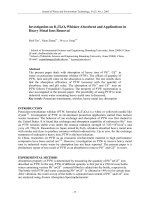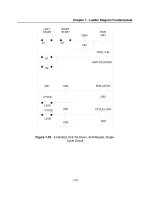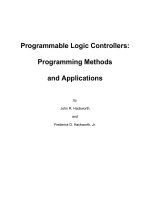zeolites and catalysis synthesis, reactions and applications - wiley
Bạn đang xem bản rút gọn của tài liệu. Xem và tải ngay bản đầy đủ của tài liệu tại đây (11.36 MB, 911 trang )
Zeolites and Catalysis
Synthesis, Reactions and Applications
Edited by
Ji
ˇ
r
´
ı
ˇ
Cejka, Avelino Corma, and Stacey Zones
Zeolites and Catalysis
Edited by
Ji
ˇ
r
´
ı
ˇ
Cejka, Avelino Corma, and Stacey Zones
Related Titles
Blaser, H U., Federsel, H J. (eds.)
Asymmetric Catalysis on
Industrial Scale
Challenges, Approaches and Solutions
2010
ISBN: 978-3-527-32489-7
Mizuno, N. (ed.)
Modern Heterogeneous
Oxidation Catalysis
Design, Reactions and Characterization
2009
ISBN: 978-3-527-31859-9
Barbaro, P., Bianchini, C. (eds.)
Catalysis for Sustainable Energy
Production
2009
ISBN: 978-3-527-32095-0
Crabtree, R. H. (ed.)
Handbook of Green Chemistry -
Green Catalysis
Three Volumes
2009
ISBN: 978-3-527-31577-2
Ozkan, U. S. (ed.)
Design of Heterogeneous
Catalysts
New Approaches based on Synthesis,
Characterization and Modeling
2009
ISBN: 978-3-527-32079-0
Swiegers, G.
Mechanical Catalysis
Methods of Enzymatic, Homogeneous,
and Heterogeneous Catalysis
Hardcover
ISBN: 978-0-470-26202-3
Jackson, S. D., Hargreaves, J. S. J. (eds.)
Metal Oxide Catalysis
2009
ISBN: 978-3-527-31815-5
Ding, K., Uozumi, Y. (eds.)
Handbook of Asymmetric
Heterogeneous Catalysis
2008
ISBN: 978-3-527-31913-8
Ertl, G., Kn¨ozinger, H., Sch¨uth, F.,
Weitkamp, J. (eds.)
Handbook of Heterogeneous
Catalysis
Eight Volumes
2008
ISBN: 978-3-527-31241-2
Zeolites and Catalysis
Synthesis, Reactions and Applications
Edited by
Ji
ˇ
r
´
ı
ˇ
Cejka, Avelino Corma, and Stacey Zones
The Editor
Prof. Dr. Jiˇr
´
ı
ˇ
Cejka
Academy of Sciences of the Czech Republic
Heyrovsk
´
y Institute of Physical Chemistry
Dokj
ˇ
skova
Dolejskova 3
182 23 Prague 8
Czech Republic
Prof. Dr. Avelino Corma
University Politecnica de Valencia
InstitutedeTecnologiaQuimica
Avenida de los Naranjos s/n
46022 Valencia
Spain
Prof. Dr. Stacey I. Zones
Chevron Texaco Energy Research
and Technology Company
100 Chevron Road
Richmond, CA 94802
USA
All books published by Wiley-VCH are
carefully produced. Nevertheless, authors,
editors, and publisher do not warrant the
information contained in these books,
including this book, to be free of errors.
Readers are advised to keep in mind that
statements, data, illustrations, procedural
details or other items may inadvertently be
inaccurate.
Library of Congress Card No.: applied for
British Library Cataloguing-in-Publication
Data
A catalogue record for this book is available
from the British Library.
Bibliographic information published by
the Deutsche Nationalbibliothek
The Deutsche Nationalbibliothek lists this
publication in the Deutsche Nationalbib-
liografie; detailed bibliographic data are
available on the Internet at
.
2010 WILEY-VCH Verlag GmbH & Co.
KGaA, Weinheim
All rights reserved (including those of
translation into other languages). No part
of this book may be reproduced in any
form – by photoprinting, microfilm, or any
other means – nor transmitted or translated
into a machine language without written
permission from the publishers. Registered
names, trademarks, etc. used in this book,
even when not specifically marked as such,
are not to be considered unprotected by law.
Composition Laserwords Private Limited,
Chennai
Printing and Bookbinding strauss GmbH,
M
¨
orlenbach
Cover Design Formgeber, Eppelheim
Printed in the Federal Republic of Germany
Printed on acid-free paper
ISBN: 978-3-527-32514-6
V
Contents to Volume 1
Preface XIII
List of Contributors XVII
1 Synthesis Mechanism: Crystal Growth and Nucleation 1
Pablo Cubillas and Michael W. Anderson
1.1 Introduction 1
1.2 Theory of Nucleation and Growth 3
1.2.1 Nucleation 3
1.2.2 Supersaturation 3
1.2.3 Energetics 4
1.2.4 Nucleation Rate 5
1.2.5 Heterogeneous and Secondary Nucleation 5
1.2.6 Induction Time 6
1.2.7 Crystal Growth 6
1.2.8 Crystal Surface Structure 6
1.2.9 2D Nucleation Energetics 8
1.2.10 Spiral Growth 9
1.2.11 Interlaced Spirals 10
1.2.12 Growth Mechanisms: Rough and Smooth Surfaces 10
1.3 Nucleation and Growth in Zeolites 11
1.3.1 Overview 11
1.3.2 Zeolite Nucleation 13
1.3.3 Crystal Growth on Zeolites and Zeotypes 14
1.4 Techniques 15
1.4.1 The Solid Crystal 15
1.4.1.1 AFM 15
1.4.1.2 HRSEM 16
1.4.1.3 Confocal Microscopy 16
1.4.2 Solution Chemistry – Oligomers and Nanoparticles 17
1.4.2.1 Nuclear Magnetic Resonance 17
1.4.2.2 Mass Spectrometry 19
Zeolites and Catalysis, Synthesis, Reactions and Applications. Vol. 1.
Edited by Ji
ˇ
r
´
ı
ˇ
Cejka, Avelino Corma, and Stacey Zones
Copyright
2010 WILEY-VCH Verlag GmbH & Co. KGaA, Weinheim
ISBN: 978-3-527-32514-6
VI Contents
1.4.2.3 Cryo-TEM 20
1.4.3 Modeling 21
1.4.3.1 Monte Carlo Modeling of Crystal Growth 21
1.5 Case Studies 23
1.5.1 Zeolite A 23
1.5.1.1 Thompson Synthesis 24
1.5.1.2 Petranovskii Synthesis 26
1.5.2 Silicalite 28
1.5.3 LTL 33
1.5.4 STA-7 35
1.5.4.1 {001} Faces 38
1.5.4.2 {001} Faces 38
1.5.5 Zincophosphates 43
1.5.5.1 ZnPO
4
-Sodalite 43
1.5.5.2 ZnPO
4
-Faujasite 47
1.5.6 Metal Organic Frameworks 47
1.6 Conclusions and Outlook 49
References 50
2 Synthesis Approaches 57
Karl G. Strohmaier
2.1 Introduction 57
2.2 Aluminophosphates 58
2.3 Mineralizers 59
2.4 Dry Gel Conversion Syntheses 61
2.5 Low Water Syntheses 62
2.6 Germanium Zeolites 63
2.7 Isomorphous Substitution 65
2.8 Structure-Directing Agents 67
2.9 SDA Modeling 70
2.10 Co-templating 72
2.11 Layered Precursors 73
2.12 Nonaqueous Solvents 77
2.13 Summary and Outlook 79
Acknowledgments 80
References 80
3 Ionothermal Synthesis of Zeolites and Other Porous Materials 87
Russell E. Morris
3.1 Introduction 87
3.2 Hydrothermal, Solvothermal, and Ionothermal Synthesis 89
3.3 Ionothermal Aluminophosphate Synthesis 90
3.4 Ionothermal Synthesis of Silica-Based Zeolites 92
Contents VII
3.5 Ionothermal Synthesis of Metal Organic Frameworks and
Coordination Polymers 92
3.6 Ambient Pressure Ionothermal Synthesis 93
3.7 The Role of Cation-Templating, Co-Templating, or No
Templating 95
3.8 The Role of the Anion – Structure Induction 97
3.9 The Role of Water and Other Mineralizers 99
3.10 Unstable Ionic Liquids 101
3.11 Summary and Outlook 101
References 102
4 Co-Templates in Synthesis of Zeolites 107
Joaquin P´erez-Pariente, Raquel Garc´ıa, Luis G´omez-Hortig¨uela,
and Ana Bel´en Pinar
4.1 Introduction 107
4.2 Templating of Dual-Void Structures 108
4.3 Crystallization of Aluminophosphate-Type Materials 113
4.4 Combined Use of Templating and Pore-Filling Agents 116
4.5 Cooperative Structure-Directing Effects of Organic Molecules and
Mineralizing Anions 117
4.6 Cooperative Structure-Directing Effect of Organic Molecules and
Water 119
4.7 Control of Crystal Size and Morphology 122
4.8 Membrane Systems 123
4.9 Use of Co-Templates for Tailoring the Catalytic Activity of Microporous
Materials 123
4.10 Summary and Outlook 125
Acknowledgments 127
References 127
5 Morphological Synthesis of Zeolites 131
Sang-Eon Park and Nanzhe Jiang
5.1 Introduction 131
5.2 Morphology of Large Zeolite Crystals 132
5.2.1 Large Crystals of Natural Zeolites 132
5.2.2 Synthesis of Large Zeolite Crystals 133
5.3 Morphology Control of MFI Zeolite Particles (of Size Less than
100 µm) 138
5.3.1 Dependence of Structure-Directing Agents (SDAs) 139
5.3.2 Dependence on Alkali-Metal Cations 141
5.4 Morphological Synthesis by MW 142
5.4.1 Examples of MW Dependency 142
5.4.2 Morphological Fabrication by MW 143
5.4.3 Formation Scheme of Stacked Morphology 146
5.5 Summary and Outlook 149
VIII Contents
Acknowledgments 150
References 150
6 Post-synthetic Treatment and Modification of Zeolites 155
Cong-Yan Chen and Stacey I. Zones
6.1 Introduction 155
6.2 Direct Synthesis of Zeolites 155
6.3 Post-synthetic Treatment and Modification of Zeolites 157
6.3.1 Aluminum Reinsertion into Zeolite Framework Using Aqueous
Al(NO
3
)
3
Solution under Acidic Conditions 158
6.3.1.1 Experimental Procedures 158
6.3.1.2 One-Step Method versus Two-Step Method 159
6.3.1.3 Effects of the Ratio of Al(NO
3
)
3
to Zeolite 160
6.3.1.4 Effects of pH, Time, Temperature, and Other Factors 161
6.3.1.5 Applicable to Medium Pore Zeolite? 161
6.3.2 Synthesis of Hydrophobic Zeolites by Hydrothermal Treatment with
Acetic Acid 162
6.3.2.1 Experimental Procedures 162
6.3.2.2 Highly Crystalline Pure-Silica Zeolites Prepared via This
Technique 163
6.3.2.3 Effects of Type of Acid, pH, Temperature, and Other Factors 163
6.3.2.4 Experimental Results from Our Lab 164
6.4 Summary and Outlook 166
Acknowledgments 167
References 167
7 Structural Chemistry of Zeolites 171
Paul A. Wright and Gordon M. Pearce
7.1 Introduction 171
7.2 Zeolite Structure Types Exemplified by Those Based on the Sodalite
Cage 172
7.2.1 Introduction 172
7.2.2 The Framework: Secondary Building Units in Zeolite Structural
Chemistry 175
7.2.3 Assembling Sodalite Cages: Sodalite, A, Faujasites X and Y, and
EMC-2 177
7.2.4 Faujasitic Zeolites X and Y as Typical Examples 178
7.2.5 Key Inorganic Cation-Only Zeolites Pre-1990 179
7.2.6 Structures Templated by Simple Alkylammonium Ions 182
7.2.7 Lessons from Nature 184
7.3 The Expanding Library of Zeolite Structures: Novel Structures,
Novel Features 185
7.3.1 Introduction 185
7.3.2 Novel Structures and Pore Geometries 187
7.3.3 Expansion of the Coordination Sphere of Framework Atoms 191
Contents IX
7.3.4 The Current Limits of Structural Complexity in Zeolites 193
7.3.5 Chirality and Mesoporosity 195
7.3.6 Ordered Vacancies and Growth Defects 197
7.3.7 Zeolites from Layered Precursors 198
7.3.8 Substitution of Framework Oxygen Atoms 199
7.4 Summary and Outlook 201
7.4.1 Summary 201
7.4.2 Outlook 202
References 204
8 Vibrational Spectroscopy and Related In situ Studies of Catalytic
Reactions Within Molecular Sieves 209
Eli Stavitski and Bert M. Weckhuysen
8.1 Introduction 209
8.2 Acidity Determination with IR Spectroscopy of Probe Molecules 211
8.3 Zeolite Synthesis Processes 218
8.4 Selection of Zeolite-Based Catalytic Reactions 221
8.4.1 Catalytic Decomposition of Nitric Oxides 221
8.4.2 Methanol-to-Olefin Conversion 225
8.5 IR Microspectroscopy 231
8.6 Concluding Remarks and Look into the Future 232
Acknowledgment 234
References 234
9 Textural Characterization of Mesoporous Zeolites 237
Lei Zhang, Adri N.C. van Laak, Petra E. de Jongh, and Krijn P. de Jong
9.1 Introduction 237
9.2 Methods for Generating Meso- and Macropores in Zeolites 239
9.2.1 Postsynthesis Modification 239
9.2.1.1 Dealumination 239
9.2.1.2 Desilication 241
9.2.1.3 Detitanation 242
9.2.2 Templating Method 243
9.2.2.1 Hard Template 243
9.2.2.2 Soft Template 244
9.2.3 Other Methods 245
9.3 Characterization of Textural Properties of Mesoporous Zeolites 246
9.3.1 Gas Physisorption 246
9.3.2 Thermoporometry 251
9.3.3 Mercury Porosimetry 255
9.3.4 Electron Microscopy 256
9.3.4.1 SEM and TEM 256
9.3.5 NMR Techniques 266
9.3.5.1
129
Xe NMR Spectroscopy 266
9.3.5.2 PFG NMR 269
X Contents
9.3.6 In situ Optical and Fluorescence Microscopy 271
9.4 Summary and Outlook 273
Acknowledgments 274
References 274
10 Aluminum in Zeolites: Where is it and What is its Structure? 283
Jeroen A. van Bokhoven and Nadiya Danilina
10.1 Introduction 283
10.2 Structure of Aluminum Species in Zeolites 284
10.2.1 Reversible versus Irreversible Structural Changes 285
10.2.2 Cautionary Note 286
10.2.3 Development of Activity and Changing Aluminum Coordination 286
10.3 Where is the Aluminum in Zeolite Crystals? 289
10.3.1 Aluminum Zoning 289
10.3.2 Aluminum Distribution Over the Crystallographic T Sites 292
10.4 Summary and Outlook 296
Acknowledgment 298
References 298
11 Theoretical Chemistry of Zeolite Reactivity 301
Evgeny A. Pidko and Rutger A. van Santen
11.1 Introduction 301
11.2 Methodology 302
11.2.1 Ab initio Methods 303
11.2.2 DFT Methods 303
11.2.3 Basis Sets 304
11.2.4 Zeolite Models 306
11.3 Activation of Hydrocarbons in Zeolites: The Role of Dispersion
Interactions 307
11.4 Molecular-Level Understanding of Complex Catalytic Reactions: MTO
Process 316
11.5 Molecular Recognition and Confinement-Driven Reactivity 321
11.6 Structural Properties of Zeolites: Framework Al Distribution and
Structure and Charge Compensation of Extra-framework Cations 326
11.7 Summary and Outlook 330
References 331
12 Modeling of Transport and Accessibility in Zeolites 335
Sof´ıa Calero Diaz
12.1 Introduction 335
12.2 Molecular Models 336
12.2.1 Modeling Zeolites and Nonframework Cations 336
12.2.2 Modeling Guest Molecules 337
12.3 Simulation Methods 338
12.3.1 Computing Adsorption 339
Contents XI
12.3.2 Computing Free Energy Barriers 341
12.3.3 Computing Volume-Rendered Pictures, Zeolite Surface Areas,
and Zeolite Pore Volumes 343
12.3.4 Computing Diffusion 344
12.4 Molecular Modeling Applied to Processes Involving Zeolites 346
12.4.1 Applications in Technological Processes 346
12.4.1.1 Molecular Modeling of Confined Water in Zeolites 346
12.4.1.2 Molecular Modeling of Hydrocarbons in Zeolites 348
12.4.1.3 Molecular Modeling of Separation of Mixtures in Zeolites 349
12.4.2 Applications in Green Chemistry 351
12.4.2.1 Carbon Dioxide Capture 351
12.4.2.2 Natural Gas Purification 352
12.5 Summary and Outlook 353
Acknowledgments 354
References 354
13 Diffusion in Zeolites – Impact on Catalysis 361
Johan van den Bergh, Jorge Gascon, and Freek Kapteijn
13.1 Introduction 361
13.2 Diffusion and Reaction in Zeolites: Basic Concepts 362
13.2.1 Importance of Adsorption 364
13.2.2 Self-Diffusivity 364
13.2.3 Mixture Diffusion 365
13.2.4 Diffusion Measurement Techniques 365
13.2.5 Relating Diffusion and Catalysis 366
13.3 Diffusion in Zeolites: Potential Issues 368
13.3.1 Concentration Dependence of Diffusion 368
13.3.2 Single-File Diffusion 370
13.3.3 Surface Barriers 372
13.3.4 The Thiele Concept: A Useful Approach in Zeolite Catalysis? 374
13.4 Pore Structure, Diffusion, and Activity at the Subcrystal Level 375
13.5 Improving Transport through Zeolite Crystals 379
13.6 Concluding Remarks and Future Outlook 382
References 383
Contents to Volume 2
14 Special Applications of Zeolites 389
V´ıctor Sebasti´an,ClaraCasado,andJoaqu´ın Coronas
15 Organization of Zeolite Microcrystals 411
Kyung Byung Yoon
XII Contents
16 Industrial Potential of Zeolites 449
Giuseppe Bellussi, Angela Carati, and Roberto Millini
17 Catalytically Active Sites: Generation and Characterization 493
Michael Hunger
18 Cracking and Hydrocracking 547
Marcello Rigutto
19 Reforming and Upgrading of Diesel Fractions 585
Carlo Perego, Vincenzo Calemma, and Paolo Pollesel
20 Recent Development in Transformations of Aromatic Hydrocarbons
over Zeolites 623
Sulaiman Al-Khattaf, Mohammad Ashraf Ali, and Jiˇr´ı
ˇ
Cejka
21 Advanced Catalysts Based on Micro- and Mesoporous Molecular Sieves
for the Conversion of Natural Gas to Fuels and Chemicals 649
Agust´ın Mart´ınez, Gonzalo Prieto, Andr´es Garc´ıa-Trenco,
and Ernest Peris
22 Methanol to Olefins (MTO) and Methanol to Gasoline (MTG) 687
Michael St¨ocker
23 Metals in Zeolites for Oxidation Catalysis 713
Takashi Tatsumi
24 Environmental Catalysis over Zeolites 745
Gabriele Centi and Siglinda Perathoner
25 Zeolites as Catalysts for the Synthesis of Fine Chemicals 775
Maria J. Climent, Avelino Corma, and Sara Iborra
26 Zeolites and Molecular Sieves in Fuel Cell Applications 827
King Lun Yeung and Wei Han
Index 863
V
Contents to Volume 1
1 Synthesis Mechanism: Crystal Growth and Nucleation 1
Pablo Cubillas and Michael W. Anderson
2 Synthesis Approaches 57
Karl G. Strohmaier
3 Ionothermal Synthesis of Zeolites and Other Porous Materials 87
Russell E. Morris
4 Co-Templates in Synthesis of Zeolites 107
Joaquin P´erez-Pariente, Raquel Garc´ıa, Luis G´omez-Hortig¨uela, and Ana
Bel´en Pinar
5 Morphological Synthesis of Zeolites 131
Sang-Eon Park and Nanzhe Jiang
6 Post-synthetic Treatment and Modification of Zeolites 155
Cong-Yan Chen and Stacey I. Zones
7 Structural Chemistry of Zeolites 171
Paul A. Wright and Gordon M. Pearce
8 Vibrational Spectroscopy and Related In situ Studies of Catalytic
Reactions Within Molecular Sieves 209
Eli Stavitski and Bert M. Weckhuysen
9 Textural Characterization of Mesoporous Zeolites 237
Lei Zhang, Adri N.C. van Laak, Petra E. de Jongh, and Krijn P. de Jong
10 Aluminum in Zeolites: Where is it and What is its Structure? 283
Jeroen A. van Bokhoven and Nadiya Danilina
Zeolites and Catalysis, Synthesis, Reactions and Applications. Vol. 2.
Edited by Ji
ˇ
r
´
ı
ˇ
Cejka, Avelino Corma, and Stacey Zones
Copyright
2010 WILEY-VCH Verlag GmbH & Co. KGaA, Weinheim
ISBN: 978-3-527-32514-6
VI Contents
11 Theoretical Chemistry of Zeolite Reactivity 301
Evgeny A. Pidko and Rutger A. van Santen
12 Modeling of Transport and Accessibility in Zeolites 335
Sof´ıa Calero Diaz
13 Diffusion in Zeolites – Impact on Catalysis 361
Johan van den Bergh, Jorge Gascon, and Freek Kapteijn
Contents to Volume 2
Preface XIII
List of Contributors XVII
14 Special Applications of Zeolites 389
V´ıctor Sebasti´an, Clara Casado, and Joaqu´ın Coronas
14.1 Introduction 389
14.2 Zeolite Membranes 389
14.2.1 Membrane Reactors and Microreactors 390
14.2.2 Zeolite-Based Gas Sensors 392
14.2.3 Mixed-Matrix Membranes 394
14.3 Host–Guest Interactions 396
14.4 Medical and Veterinary Applications 399
14.4.1 Medical Applications 399
14.4.2 Veterinary Applications 400
14.5 Other Applications 401
14.5.1 Racemic Separations 401
14.5.2 Magnetic Zeolites 402
14.5.3 Hydrogen Storage 403
14.6 Summary and Outlook 404
References 406
15 Organization of Zeolite Microcrystals 411
Kyung Byung Yoon
15.1 Introduction 411
15.2 Organization of Zeolite Microcrystals into Functional Materials by
Self-Assembly 411
15.2.1 Monolayer Assembly on Solid Substrates 412
15.2.1.1 Types of Linkages 412
15.2.1.2 Types of Substrates 415
15.2.1.3 Methods 415
15.2.1.4 Characteristic Points to Monitor the Quality of the Monolayers 416
Contents VII
15.2.1.5 Four Key Processes Occurring during Monolayer Assembly 417
15.2.1.6 Effect of Method on Rate, DCP, Coverage, and Binding Strength 424
15.2.1.7 Factors Affecting Binding Strengths 426
15.2.1.8 Driving Forces for Uniform Orientation and Close Packing 427
15.2.2 Patterned Monolayer Assembly on Substrates 429
15.2.3 Multilayer Assembly on Substrates 431
15.2.4 Organization into 2D Arrays on Water 431
15.2.5 Organization into Surface-Aligned Zeolite Microballs 434
15.2.6 Self-Assembly of Substrate-Tethering Zeolite Crystals with
Proteins 435
15.2.7 In Situ Self-Organization of Zeolite Crystals into Arrays during
Synthesis 437
15.3 Monolayer Assembly of Zeolite Microcrystals by Dry Manual
Assembly 438
15.4 Current and Future Applications 441
15.5 Summary and Outlook 442
Acknowledgments 444
References 444
16 Industrial Potential of Zeolites 449
Giuseppe Bellussi, Angela Carati, and Roberto Millini
16.1 Introduction 449
16.2 Application of Zeolites in Slurry Processes 450
16.2.1 TS-1 Based Catalyst for Liquid-Phase Oxidation Processes 451
16.2.2 New Advance in Slurry Phase Reaction with Zeolitic Catalysts 453
16.3 Rebalancing the Refinery Products Slate 455
16.3.1 Bottom Cracking Conversion 457
16.3.2 LCO Upgrading 459
16.3.3 Olefins Oligomerization 461
16.4 Advanced Separation Technologies 462
16.5 Zeolites and Environmental Protection: Groundwater
Remediation 467
16.6 New Materials for Emerging Applications 471
16.6.1 Zeolites 471
16.6.2 Hierarchical Zeolites 473
16.6.3 Silica-Based Crystalline Organic–Inorganic Hybrid Materials 479
16.7 Summary and Outlook 484
References 485
17 Catalytically Active Sites: Generation and Characterization 493
Michael Hunger
17.1 Introduction 493
17.2 Acid Sites in Zeolites 494
17.2.1 Nature of Acid Sites 494
17.2.2 Formation of Brønsted and Lewis Acid Sites 496
VIII Contents
17.3 Characterization of Acid Sites 498
17.3.1 Catalytic Test Reactions 498
17.3.2 Titration with Bases 500
17.3.3 Temperature-Programmed Desorption of Bases 501
17.3.4 Microcalorimetry 504
17.3.5 FTIR Spectroscopy 508
17.3.6 NMR Spectroscopy 514
17.4 Base Catalysis 521
17.4.1 Nature of Base Sites 521
17.4.2 Formation of Base Sites 522
17.5 Characterization of Base Sites in Zeolites 523
17.5.1 Test Reactions 523
17.5.2 Analytical and Spectroscopic Methods 525
17.6 Metal Clusters in Zeolites 529
17.6.1 Nature of Metal Clusters 529
17.6.2 Formation of Metal Clusters 530
17.7 Characterization of Metal Clusters in
Zeolites 532
17.7.1 Test Reactions 532
17.7.2 Analytical Methods 534
17.8 Summary and Outlook 535
References 535
18 Cracking and Hydrocracking 547
Marcello Rigutto
18.1 Introduction 547
18.1.1 The Oil Refinery – Where to Find Zeolites in It, and Why – and the
Place of Hydrocracking and Catalytic Cracking 547
18.1.2 The Changing Environment for Refining 549
18.2 FCC 551
18.2.1 The FCC Process 551
18.2.2 The FCC Catalyst, and Catalytic Chemistry 555
18.2.3 Residue Cracking and the Effect of Deposited Metals on the
Catalyst 558
18.2.4 Light Alkenes by Addition of ZSM-5 559
18.2.5 Potential Use of Other Zeolites in FCC 561
18.3 Hydrocracking 561
18.3.1 The Hydrocracking Process 561
18.3.2 Feedstocks and Products 563
18.3.3 Hydrocracking Catalyst Systems, and Catalytic Chemistry 566
18.3.4 Zeolite Y in Hydrocracking 570
18.3.5 New Catalyst Developments 575
18.3.6 Residue Conversion – Some Notes 576
18.4 Summary and Outlook 576
References 578
Contents IX
19 Naphtha Reforming and Upgrading of Diesel Fractions 585
Carlo Perego, Vincenzo Calemma, and Paolo Pollesel
19.1 Introduction 585
19.2 Catalytic Reforming 587
19.2.1 Process 587
19.2.2 Reforming Chemistry 591
19.2.3 Catalyst 595
19.2.3.1 Zeolite Catalysts 598
19.2.3.2 Commercial Catalysts 600
19.3 Upgrading Diesel Fractions: Catalytic Dewaxing 601
19.3.1 Shape Selectivity 602
19.3.1.1 Catalytic Dewaxing via Shape Selective Cracking 605
19.3.1.2 Dewaxing via Isomerization 607
19.3.2 Commercial Applications 609
19.3.2.1 Commercial Processes 610
19.4 Summary and Outlook 618
References 619
20 Recent Development in Transformations of Aromatic Hydrocarbons
over Zeolites 623
Sulaiman Al-Khattaf, Mohammad Ashraf Ali, and Jiˇr´ı
ˇ
Cejka
20.1 Introduction 623
20.2 Zeolites under Study 623
20.3 Toluene Disproportionation 625
20.3.1 Zeolite Modification by Silicon Deposition 626
20.3.2 Zeolite Modification by Precoking 627
20.3.3 Zeolite Modification by Dealumination 627
20.3.4 Zeolite Modification by Metal Deposition 628
20.3.5 Factors Affecting Toluene Disproportionation 629
20.4 Ethylbenzene Disproportionation 630
20.4.1 Effect of Crystal Size and Surface Modification 631
20.4.2 Kinetic Investigations of Ethylbenzene
Disproportionation 631
20.5 Disproportionation and Transalkylation of
Trimethylbenzene 633
20.6 Alkylation of Aromatics 635
20.6.1 Ethylation of Benzene 635
20.6.2 Methylation of Toluene 636
20.6.2.1 Modification of the External Surface of Zeolites 638
20.6.3 Ethylation of Toluene and Ethylbenzene 640
20.7 Miscellaneous 642
20.8 Summary and Outlook 643
Acknowledgments 644
References 644
X Contents
21 Advanced Catalysts Based on Micro- and Mesoporous Molecular Sieves
for the Conversion of Natural Gas to Fuels and Chemicals 649
Agust´ın Mart´ınez, Gonzalo Prieto, Andr´es Garc´ıa-Trenco,
and Ernest Peris
21.1 Introduction 649
21.2 Direct Conversion of Methane 651
21.2.1 Oxidative Conversion: OCM and Methylation Processes 651
21.2.2 Nonoxidative Methane Homologation and Alkylation
Processes 654
21.2.3 Nonoxidative Methane Dehydroaromatization (MDA) 655
21.3 Syngas Conversion Processes 659
21.3.1 Selective Synthesis of Short-Chain (C
2
–C4) Olefins 659
21.3.2 Fischer–Tropsch Synthesis (FTS) 663
21.3.2.1 Conventional FTS 663
21.3.2.2 Modified (Bifunctional) FTS 668
21.3.3 Synthesis of Oxygenates 670
21.3.3.1 One-Step Synthesis of Dimethyl Ether (DME)
from Syngas 670
21.3.3.2 Syngas to Higher (C2
+
) Oxygenates 674
21.3.3.3 Carbonylation of MeOH and DME 676
21.4 Summary and Outlook 678
Acknowledgments 680
References 680
22 Methanol to Olefins (MTO) and Methanol to Gasoline (MTG) 687
Michael St¨ocker
22.1 Introduction 687
22.2 Mechanism and Kinetics of the MTO and MTG Reactions 690
22.3 Methanol to Olefins (MTO) 697
22.3.1 Catalysts and Reaction Conditions 697
22.3.2 Deactivation 697
22.3.3 Process Technology and Design 699
22.3.4 Commercial Aspects/Economic Impact 700
22.3.5 Future Perspectives 701
22.4 Methanol to Gasoline (MTG) 702
22.4.1 Catalysts and Reaction Conditions 702
22.4.2 Deactivation 702
22.4.3 Process Technology 703
22.5 Methanol to Propene (MTP) 703
22.6 TIGAS Process 705
22.7 Mobil’s Olefin-to-Gasoline and Distillate Process
(MOGD) 706
22.7.1 Catalyst and Process Operation 706
22.7.2 Thermodynamic Considerations 706
22.7.3 Technical Process 707
Contents XI
22.8 Summary and Outlook 707
22.9 Outlook 708
References 708
23 Metals in Zeolites for Oxidation Catalysis 713
Takashi Tatsumi
23.1 Introduction 713
23.2 Titanium-Containing Zeolites 715
23.2.1 TS-1 715
23.2.2 Ti-Beta 722
23.2.3 Ti-MWW 724
23.2.4 Other Titanium-Containing Zeolites 731
23.2.5 Solvent Effects and Reaction Intermediate 732
23.3 Other-Metal-Containing Zeolites 736
23.4 Conclusion 738
References 739
24 Environmental Catalysis over Zeolites 745
Gabriele Centi and Siglinda Perathoner
24.1 Introduction 745
24.2 A Glimpse into Opportunities and Issues 746
24.3 Fields of Applications 756
24.4 Summary and Outlook 769
References 770
25 Zeolites as Catalysts for the Synthesis of Fine Chemicals 775
Maria J. Climent, Avelino Corma, and Sara Iborra
25.1 Introduction 775
25.2 Acid-Catalyzed Reactions 775
25.2.1 Friedel–Crafts Acylation 775
25.2.2 Hydroxyalkylation of Aromatic Compounds 780
25.2.3 Diels–Alder Reactions 783
25.2.4 Acetalization of Carbonyl Compounds 787
25.2.5 Fischer Glycosidation Reactions 789
25.2.6 Isomerization Reactions: Isomerization of
α-Pinene and α-Pinene Oxide 792
25.2.7 Oxidation and Reduction Reactions 795
25.2.7.1 Epoxidation Reactions 795
25.2.7.2 Baeyer–Villiger Oxidations 799
25.2.7.3 Meerwein–Ponndorf Verley Reduction and Oppenauer Oxidation
(MPVO) 803
25.3 Base-Catalyzed Reactions 808
25.3.1 The Knoevenagel Condensation 809
25.3.2 Michael Addition 813
25.3.3 Aldol Condensations 816
XII Contents
25.4 Summary and Outlook 819
References 819
26 Zeolites and Molecular Sieves in Fuel Cell Applications 827
King Lun Yeung and Wei Han
26.1 Introduction 827
26.2 Zeolites in Electrolyte Membrane 827
26.2.1 Zeolite Conductivities 829
26.2.2 Zeolite/Polymer Composite Membranes 833
26.2.2.1 Zeolite/PTFE Composite Membranes 839
26.2.2.2 Zeolite/PFSA Composite Membranes 839
26.2.2.3 Zeolite/Chitosan Composite Membranes and Others 840
26.2.2.4 Self-Humidifying Composite Membranes 841
26.2.3 Zeolite and Mesoporous Inorganic Membranes 841
26.3 Zeolite Electrocatalysts 842
26.4 Zeolites and Molecular Sieves in Fuel Processing 844
26.4.1 Removal of Sulfur Compounds in Fuel 845
26.4.2 Hydrogen Production and Purification 845
26.4.2.1 Reforming of Hydrocarbons 845
26.4.2.2 Steam Reforming of Alcohols 849
26.4.2.3 Decomposition of CH
4
and NH
3
849
26.4.2.4 CO Removal from H
2
-Rich Gas 849
26.4.3 Hydrogen Storage 850
26.5 Summary and Outlook 856
Acknowledgment 856
References 856
Index 863
XIII
Preface
One can safely say that the impact of zeolites in science and technology in the last
50 years has no precedents in the field of materials and catalysis. Although the first
description of zeolites dates back up to 250 years ago, the last five decades experi-
enced an incredible boom in zeolite research activities resulting in the successful
synthesis of almost 200 different structural types of zeolites, numerous excellent
scientific papers on the synthesis of zeolites, characterization of their properties,
and applications of zeolites in adsorption and catalysis that have revolutionized the
petrochemical industry. In addition, based on the knowledge of zeolites several
other areas of porous materials have recently emerged including mesoporous ma-
terials, hierarchic systems, metal-organic frameworks (cationic-periodic polymers)
and mesoporous organosilicas. All these materials have substantially increased the
portfolio of novel porous materials possessing new interesting properties, but this
topic is not covered in this book.
This book consists of two volumes. The first one is mostly concentrated on recent
advances in the synthesis of zeolites and understanding of their properties while
the second volume describes recent achievements in the application of zeolites
mostly in catalysis.
More specifically, the first volume starts with a chapter by P. Cubillas and M.W.
Anderson (Chapter 1) discussing mechanisms of the synthesis of zeolites and
zeotypes, including nucleation and crystal growth, employing various microscopic
techniques. This is followed by a chapter of K. Strohmaier (Chapter 2) providing a
detailed survey on the synthesis of novel zeolites and different layered precursors
incorporating different metal ions into the framework, and applying ever increasing
number of structure-directing agents. A new approach to the synthesis of zeolites
and other porous materials by ionothermal synthesis combining ionic liquids as
the solvent together with the structure-directing agent is presented by R. Morris
(Chapter 3). Zeolite synthesis can also be controlled by a simultaneous use of two
different templates providing new tool for creative chemistry Nas discussed by the
group of J. P
´
erez-Pariente (Chapter 4). Morphological control of zeolite crystals is
one of the key issues to understand the mechanism of zeolite crystallization as well
as to control the performance of zeolites in various applications as it is outlined by
S E. Park and N. Jiang in Chapter 5. Introduction of other elements than silicon
into the zeolite framework can be done not only via synthesis but also in the
Zeolites and Catalysis, Synthesis, Reactions and Applications. Vol. 1.
Edited by Ji
ˇ
r
´
ı
ˇ
Cejka, Avelino Corma, and Stacey Zones
Copyright
2010 WILEY-VCH Verlag GmbH & Co. KGaA, Weinheim
ISBN: 978-3-527-32514-6
XIV Preface
postsynthesis steps as highlighted for deboronation followed by realumination as
described by C.Y. Chen and S.I. Zones (Chapter 6). P.A. Wright and G.M. Pearce
show how the individual zeolite structures are built from basic secondary building
units. The authors focus not only on general aspects of zeolite structures but also
on the description of structures of zeolites determined very recently (Chapter 7).
Structural and textural characterization of zeolites starts in Chapter 8, written
by E. Stavitski and B.M. Weckhuysen, providing good examples of application
of vibrational spectroscopy under static conditions that can drive into in situ
catalytic investigations. The group of K. de Jong (Chapter 9) makes an effort to
evaluate different physicochemical methods used for textural characterization of
zeolites. Gas physisorption, mercury porosimetry, electron microscopy (including
3D experiments), various NMR techniques up to in situ optical and fluorescence
microscopy are discussed in detail. The location, coordination, and accessibility
of framework aluminum are of key importance for acid-catalyzed reactions in
zeolites and these issues are addressed by J.A. van Bokhoven and N. Danilina
in Chapter 10. Theoretical background of zeolite reactivity employing different
computational approaches and models is covered in Chapter 11 by E.A. Pidko and
R.A. van Santen. S. Calero Diaz presents an overview of current developments in
modeling of transport and accessibility in zeolites showing some recent models and
simulation methods that are applied for systems of environmental and industrial
interests (Chapter 12). The final chapter of the first volume is written by the group
of F. Kapteijn (Chapter 13), in which diffusion in zeolites starting from basic
models of diffusion up to the role of diffusion in adsorption and catalytic processes
is discussed.
The second volume starts with a chapter of the group of J. Coronas concentrat-
ing on special applications of zeolites including green chemistry, hybrid materials,
medicine, veterinary, optical- and electrical-based applications, multifunctional
fabrics, and nanotechnology (Chapter 14). After that K.B. Yoon presents the op-
portunities to organize zeolite microcrystals into two- and three-dimensionally
organized structures and the application of these organized entities in membranes,
antibacterial functional fabrics, supramolecularly organized light-harvesting sys-
tems, and nonlinear optical films (Chapter 15).
The remaining chapters are exclusively devoted to the application of zeolites in
catalysis. G. Bellussi opens this part with a broad overview of current industrial
processes using zeolites as key components of the catalysts and further challenges
in this area (Chapter 16). Generation, location, and characterization of catalytically
active sites are discussed in depth by M. Hunger showing different aspects of
shape selectivity and structural effect on the properties of active sites (Chapter 17).
M. Rigutto (Chapter 18) stresses the importance of zeolites and the main reasons
for their application in cracking and hydrocracking, the largest industrial processes
employing zeolites as catalysts. Further, C. Perego and his coworkers focus on
reforming and upgrading of diesel fractions, which with gasoline are by far the most
important and valuable key fractions produced by petroleum refineries (Chapter 19).
Transformation of aromatic compounds forms the heart of petrochemical processes
with zeolites as key components of all catalysts. S. Al-Khattaf, M.A. Ali, and J.
ˇ
Cejka
Preface XV
highlight the most important recent achievements in application of zeolites in
various alkylation, isomerization, disproportionation, and transalkylation reactions
of aromatic hydrocarbons (Chapter 20). With decreasing supply of oil, natural gas
obtains more and more importance. A. Martinez and his coauthors discuss in
some detail different ways of methane upgrading into valuable fuels and chemicals
(Chapter 21). Methanol, which can be obtained from natural gas, could be one
of the strategic raw materials in future. Novel processes transforming methanol
into olefins or gasoline are covered in Chapter 22 by M. St
¨
ocker. Incorporation of
catalytically active species into zeolite frameworks or channel systems for oxidation
reactions is covered in Chapter 23 by T. Tatsumi. The main attention is devoted
to Ti-silicates. G. Centi and S. Perathoner focus on increasing applicability of
zeolites in environmental catalysis with a particular attention to conversion of
nitrogen oxides (Chapter 24). K.L. Yeung and W. Han describe the emerging field
of application of zeolites in fuel cells for clean energy generation. The authors
show that zeolites can play an important role in hydrogen production, purification,
conditioning, and storage (Chapter 25). The final chapter by the authors from
the group of A. Corma presents possibilities of application of zeolite as catalysts
in the synthesis of fine chemicals. The examples discussed include, for example,
acylation, hydroxyalkylation, acetalization, isomerization, Diels–Alder, and Fischer
glucosidation reactions.
Bringing together these excellent chapters describing the cutting edge of zeolite
research and practice provides an optimistic view for the bright future of zeolites.
The number of new synthesized zeolites is ever increasing and particularly novel
extra-large pore zeolites or even chiral zeolitic materials will surely be applied
in green catalytic processes enabling to transform bulkier substrates into desired
products. In a similar way, application of zeolites in adsorption or separation is
one of the most important applications of this type of materials saving particularly
energy needed for more complex separation processes if zeolites were not available
to do the job. Fast development of experimental techniques enables deeper insight
into the structural and textural properties of zeolites, while particularly spectro-
scopical methods provide new exciting information about the accessibility of inner
zeolite volumes and location and coordination of active sites. Catalysis is still the
most promising area for application of zeolites, in which novel zeolitic catalysts
with interesting shape-selective properties can enhance activities and selectivities
not only in traditional areas such as petrochemistry but also in environmental
protection, pollution control, green chemistry, and biomass conversion. Last but
not least, novel approaches in the manipulation and modification of zeolites di-
rected to fuel cells, light harvesting, membranes, and sensors clearly evidence a
large potential of zeolites in these new areas of application. The only limitation in
zeolite research is the lack of our imagination, which slows down our effort and
attainment of new exciting achievements.
It was our great pleasure working with many friends and excellent researchers
in the preparation of this book. We would like to thank sincerely all of them for
their timely reviews on selected topics and the great effort to put the book together.
We believe that this book on zeolites will be very helpful not only for experienced









